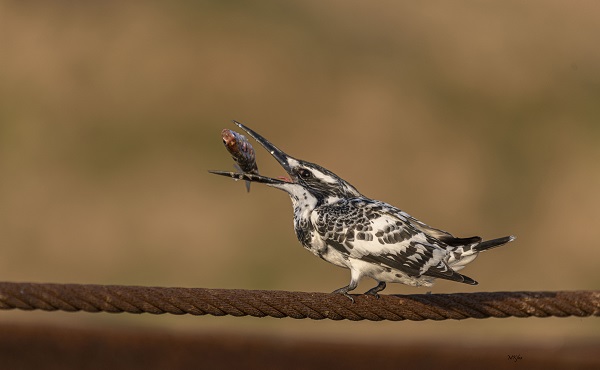Oo La La Lala Le.., I was humming the tune, while clicking the hovering Kingfisher in the sky. Suddenly it dived straight into the river. No sound of water splashing, but it immediately came out with a catch – a fish caught between its pointed beaks. It was an amazing sight to watch the Pied Kingfisher, swooping down in a spectacular dive and surfacing with its prey. The black-and-white bird with an intricate face pattern made for a striking sight. When these birds catch fish, they casually toss it into the air, reposition and swallow it, head first. Sometimes they beat big fish to break its spine, which might otherwise cause harm during ingestion. This wonderful creature, sights a fish from its perch, makes a dive into the water, without even making any splash to scare the fish, before flying back victoriously.
This incident that I witnessed reminded me of the connection between the Kingfisher and the bullet train.
Back in the early 1990s, while travelling in Japan, I heard a booming sound–the result of an air cushion building up in front of a bullet train which was being developed, when it touched a 300 kms/hour speed. One of the engineers who was working on the project, was a bird watcher. He had seen a common kingfisher diving down through the air, going into water and creating very little splash sound. Eureka. he got the idea. He shaped the snout of the train like a kingfisher’s head. Once the new aerodynamic principle was applied, the high- speed boom disappeared.
Kingfishers fly low and straight like bullets, reaching up to 50 km/hour but it’s not their speed that excites scientists and engineers; instead, it is their beaks– sharp and pointed, and one-third of the bird’s height.
Thanks to its beak, the pied kingfisher fishes in freshwater bodies, and is a fairly common bird to spot. Its black and white plumage, crest and the habit of hovering over clear lakes and rivers before diving for fish makes it distinctive.
But all kingfishers do not appear in black and white tones.

The white-throated kingfisher is the most commonly seen species of Kingfisher found in the Indian Subcontinent. The white-throated kingfisher is easily identifiable because of its electric bluish-green tinged back and upper wings. It is large-headed, predominantly chestnut-brown, with a long, heavy, and pointed dark dull-red bill, and a conspicuous white throat extending across the breast. It belongs to the genus Halcyon, which, according to legend, is a mythical bird which nests on the sea and is loved by the gods. It calms the waves as it breeds, bringing in halcyon or peaceful days.

The other species of Kingfisher is the Common kingfisher also known as River Kingfisher. Though not so common, it is found across the river forest of India and an important member of the ecosystem. Sparrow-sized, the common kingfisher or small blue kingfisher has a flash of electric blue and orange with a distinctive green-blue neck stripe and bright red legs. Contrary to the name, this little fellow is not very common compared to its larger cousin, the white-throated Kingfisher.
There are roughly 90 species of kingfishers in the world, divided into three categories–the river kingfishers, the tree kingfishers and the water kingfishers. All of them have large heads, long sharp pointed bills, short legs, and stubby tails. There are around a dozen species of these glamorous birds found in India.
But they are also vulnerable, with some of them falling in the critically endangered list drawn by the International Union for Conservation of Nature (IUCN).
Also Read:
Brahminy ducks: The Chakwa-Chakwi love birds of India




















